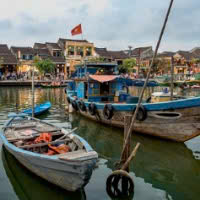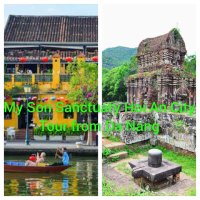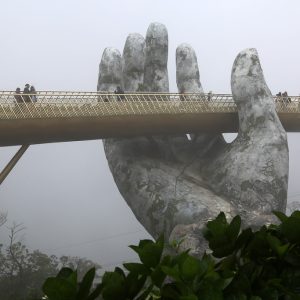Contents
- 1 I. Introduction
- 2 II. Marble Mountain
- 2.1 A. Background information about Marble Mountain
- 2.2 B. Description of the natural beauty and unique rock formations
- 2.3 C. Exploration of the caves, pagodas, and temples within Marble Mountain
- 2.4 D. Opportunities for panoramic views of the surrounding area
- 2.5 E. The significance of Marble Mountain in local folklore and spirituality
- 3 III. Hoi An
- 3.1 A. Introduction to Hoi An, a UNESCO World Heritage Site
- 3.2 B. Overview of the historical and cultural importance of Hoi An
- 3.3 C. Description of the preserved ancient town and its architectural highlights
- 3.4 D. Exploration of Hoi An’s bustling markets, traditional craft shops, and vibrant street life
- 3.5 E. Hoi An’s renowned cuisine and local specialties
- 3.6 F. Optional activities
- 4 IV. Tour Itinerary
- 5 V. Practical Information
- 5.1 A. Transportation options to Marble Mountain and Hoi An
- 5.2 B. Recommended time to allocate for the tour
- 5.3 C. Weather considerations and appropriate clothing
- 5.4 D. Tips for engaging with local vendors and navigating the crowded areas
- 5.5 E. Suggestions for additional attractions or destinations to visit in the area
- 6 VI. Marble Mountain and Hoi An Tour Price, Tour Inclusions, Tour Exclusions
- 7 VII. TRAVEL AGENT IN DANANG TO BOOK THE TRIP
- 8 VIII. Conclusion
I. Introduction
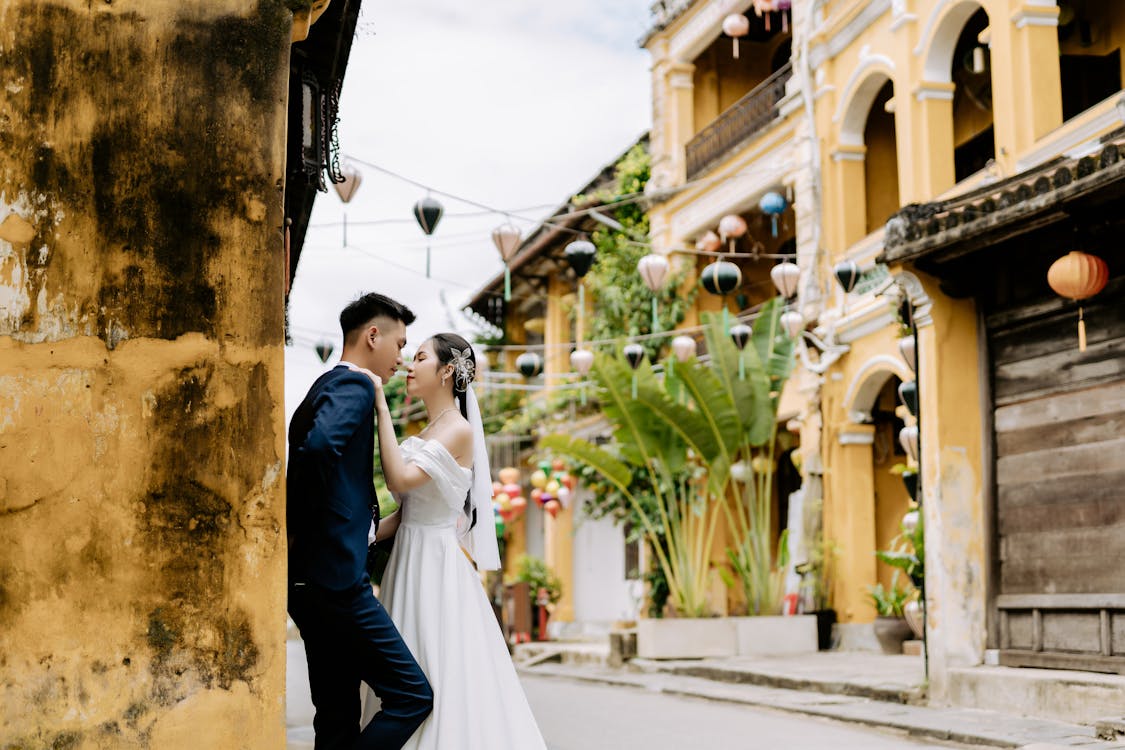
A. Brief overview of Marble Mountain and Hoi An
Marble Mountain is a cluster of five limestone hills located near Da Nang, Vietnam. It is renowned for its stunning natural beauty, intricate caves, and sacred pagodas and temples. The mountains are considered a spiritual and cultural symbol in Vietnamese folklore. On the other hand, Hoi An is a UNESCO World Heritage Site and an enchanting ancient town situated on the central coast of Vietnam. It showcases a well-preserved blend of Chinese, Japanese, and Vietnamese architectural influences. Hoi An is famous for its vibrant markets, traditional crafts, delectable cuisine, and lantern-lit streets, offering a glimpse into Vietnam’s rich history and cultural heritage.
B. Importance of these destinations in Vietnamese culture and history
Marble Mountain and Hoi An hold significant importance in Vietnamese culture and history, representing key facets of the country’s heritage.
Marble Mountain:
With its caves, pagodas, and temples, has deep spiritual significance for the Vietnamese people. It is believed to be a sacred place where heaven and earth meet, attracting pilgrims and worshippers seeking blessings and spiritual solace. The mountain’s caves served as hiding places for locals during times of war and have witnessed significant historical events. The intricate marble carvings produced in the region are also an integral part of Vietnam’s artistic and cultural legacy.
Hoi An:
A bustling trading port from the 15th to 19th centuries, reflects the cultural fusion between Vietnamese, Chinese, and Japanese influences. Its well-preserved ancient town showcases unique architectural styles, including traditional Vietnamese houses, Chinese temples, and Japanese covered bridges. Hoi An was a pivotal center for trade, contributing to the region’s economic growth and cultural exchange. The town’s markets, where locals and merchants once converged, continue to thrive, providing a glimpse into the vibrant commercial traditions of the past.
Both Marble Mountain and Hoi An serve as living testaments to Vietnam’s rich cultural heritage, offering visitors an opportunity to connect with the country’s history, spirituality, and artistic traditions.
II. Marble Mountain
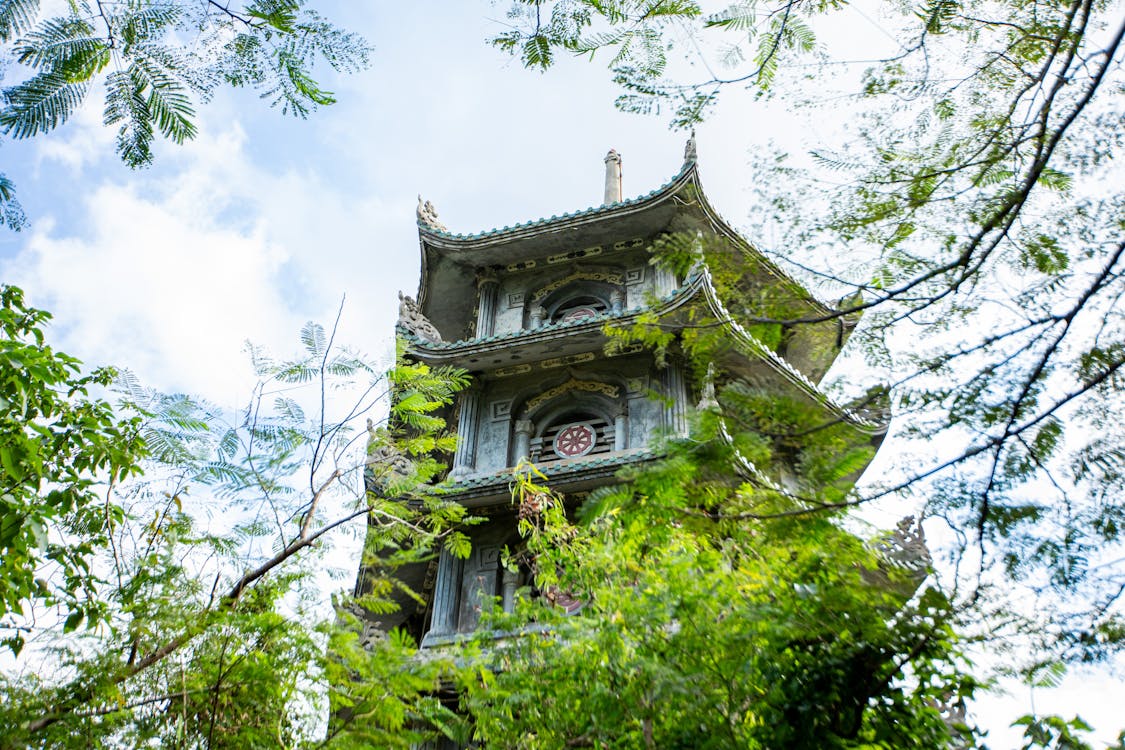
A. Background information about Marble Mountain
Marble Mountain, known as Ngu Hanh Son in Vietnamese, is a collection of five majestic limestone hills located about 9 kilometers south of Da Nang city in Central Vietnam. Each mountain is named after one of the five elements of the ancient Chinese philosophy: Thuy Son (Water), Moc Son (Wood), Hoa Son (Fire), Kim Son (Metal), and Tho Son (Earth).
These mountains have a rich geological and historical significance. Composed mainly of marble and limestone, they are renowned for their unique rock formations, caves, and grottoes, shaped over millions of years by natural forces. The marble extracted from the mountains has been used for centuries to create intricate sculptures and architectural masterpieces in Vietnam.
Marble Mountain is not only known for its natural beauty but also holds cultural and spiritual importance. The caves within the mountains house several Buddhist pagodas and Hindu temples, attracting pilgrims and worshippers who come to seek blessings and meditate. The site is considered a sacred place, symbolizing the harmonious balance between heaven and earth in Vietnamese folklore.
Due to its breathtaking vistas, cultural significance, and historical relevance, Marble Mountain has become a popular tourist destination, captivating visitors with its natural wonders and spiritual ambiance.
B. Description of the natural beauty and unique rock formations
Marble Mountain’s natural beauty is awe-inspiring, characterized by its unique rock formations and stunning landscapes. The limestone hills rise dramatically from the surrounding flat terrain, creating a striking contrast. The mountains showcase intricate and sculptural rock formations that have been shaped by the forces of nature over millennia. From towering cliffs and jagged peaks to hidden caves and grottoes adorned with stalactites and stalagmites, the landscape is a testament to the geological wonders of the region. The play of light and shadow on the marble surfaces further enhances the visual appeal, creating a mesmerizing and ethereal atmosphere. Exploring Marble Mountain allows visitors to immerse themselves in the captivating beauty of nature’s artistry.
C. Exploration of the caves, pagodas, and temples within Marble Mountain
Exploring Marble Mountain unveils a captivating world of caves, pagodas, and temples nestled within its majestic hills. The mountains are home to a network of intricate caves, each with its own unique characteristics and history. These caves serve as spiritual sanctuaries and have been transformed into serene Buddhist pagodas and Hindu temples, adorned with statues, altars, and incense. Visitors can venture into the depths of the caves, marveling at the natural formations and religious artifacts, while immersing themselves in a tranquil and sacred atmosphere. The interplay of spirituality, history, and natural beauty within the caves, pagodas, and temples of Marble Mountain creates a profound and enriching experience for all who visit.
D. Opportunities for panoramic views of the surrounding area
Marble Mountain offers enchanting panoramic views of the surrounding area, providing a breathtaking perspective of the coastal landscape and the vibrant city of Da Nang. Upon reaching the summits or designated viewpoints, visitors are rewarded with sweeping vistas of the sparkling blue sea, lush green valleys, and the bustling cityscape. The elevated vantage points allow for a sense of awe-inspiring immersion in the natural beauty of the region. Whether it’s gazing at the vast expanse of the ocean, marveling at the patchwork of rooftops in Da Nang, or witnessing the interplay of light and shadow on the landscape, the panoramic views from Marble Mountain are a feast for the eyes and a memorable highlight of the visit.
E. The significance of Marble Mountain in local folklore and spirituality
Marble Mountain holds great significance in local folklore and spirituality, deeply rooted in Vietnamese culture. According to local beliefs, the mountains are considered sacred, serving as a bridge between heaven and earth. They are believed to be the dwelling place of powerful deities and spirits. The caves within Marble Mountain are considered spiritual sanctuaries, attracting pilgrims and worshippers who come to seek blessings and enlightenment. Legends and tales surrounding the mountains further contribute to their mystique. Marble Mountain’s spiritual importance is evident in the numerous pagodas and temples that dot the landscape, where devotees engage in rituals, meditation, and prayer. The site’s rich folklore and spiritual essence make it a revered and respected place among the local population.
III. Hoi An
A. Introduction to Hoi An, a UNESCO World Heritage Site
Hoi An, a captivating ancient town nestled on Vietnam’s central coast, is a UNESCO World Heritage Site of immense cultural significance. With a history dating back over a thousand years, Hoi An showcases a harmonious blend of Vietnamese, Chinese, and Japanese influences. Its well-preserved architectural wonders, including traditional Vietnamese houses, ornate Chinese temples, and the iconic Japanese Covered Bridge, transport visitors to a bygone era. The town’s atmospheric streets are adorned with colorful lanterns, while bustling markets, traditional craft shops, and delectable cuisine add to its charm. Hoi An is a living testament to Vietnam’s rich heritage and serves as a remarkable destination for cultural exploration and immersion.
B. Overview of the historical and cultural importance of Hoi An
Hoi An holds immense historical and cultural importance as a significant trading port from the 15th to 19th centuries. It served as a vibrant hub for cultural exchange and commerce, attracting merchants from around the world. The town’s architectural marvels reflect the fusion of Vietnamese, Chinese, and Japanese influences, showcasing unique architectural styles and ornate craftsmanship. Hoi An’s historical significance extends to its role as a UNESCO World Heritage Site, preserving its ancient town and traditions. Today, Hoi An’s streets bustling with markets, traditional craft workshops, and its renowned cuisine continue to offer a glimpse into its rich cultural heritage and make it a captivating destination for visitors.
C. Description of the preserved ancient town and its architectural highlights
Hoi An’s preserved ancient town is a captivating destination that showcases architectural highlights from centuries past. Its narrow streets are lined with impeccably preserved buildings, displaying a harmonious blend of Vietnamese, Chinese, and Japanese architectural styles. The town’s wooden merchant houses, adorned with ornate carvings and colorful facades, stand as a testament to its prosperous trading history. Notable architectural landmarks include the iconic Japanese Covered Bridge, an emblem of cultural exchange, and the ornate assembly halls representing various ethnic communities. The town’s timeless charm, with its well-preserved buildings and atmospheric streets, immerses visitors in the rich architectural heritage of Hoi An.
D. Exploration of Hoi An’s bustling markets, traditional craft shops, and vibrant street life
Exploring Hoi An’s bustling markets, traditional craft shops, and vibrant street life is a feast for the senses. The markets brim with energy and color, offering a delightful array of local produce, handicrafts, and souvenirs. Walking through the vibrant streets, visitors encounter traditional craft shops where skilled artisans practice ancient techniques, creating beautiful lanterns, tailor-made clothing, ceramics, and intricate embroidery. The lively street life is enhanced by the presence of street food vendors, offering tantalizing local delicacies. The atmosphere is filled with the sounds of chatter, bargaining, and the occasional musical performance, creating a vibrant and immersive experience that showcases Hoi An’s dynamic cultural scene.
E. Hoi An’s renowned cuisine and local specialties
Hoi An is a paradise for food lovers, renowned for its delectable cuisine and local specialties. The town’s culinary scene is a vibrant fusion of Vietnamese, Chinese, and Japanese influences. Visitors can savor iconic dishes like Cao Lau, a flavorful noodle dish with roast pork and fresh herbs, or the famous White Rose dumplings, delicate steamed shrimp dumplings. Hoi An is also celebrated for its street food, with vendors offering mouthwatering Banh Mi sandwiches, crispy Banh Xeo pancakes, and savory Quang-style noodles. Exploring the local markets reveals an abundance of fresh produce, herbs, and spices, adding depth and authenticity to the flavors of Hoi An’s gastronomic delights.
F. Optional activities
1. boat ride on the Thu Bon River
Embarking on a boat ride along the Thu Bon River offers a wonderful opportunity to visit the charming pottery and carpentry villages near Hoi An. As the boat glides along the tranquil waters, visitors can explore Thanh Ha, a renowned pottery village. Here, artisans create exquisite ceramics using traditional techniques passed down through generations. Continuing the journey, the boat reaches Kim Bong, a carpentry village famous for its skilled craftsmen. Witnessing their intricate woodworking skills and observing the creation of beautiful wooden furniture and sculptures provides a glimpse into the rich artistic heritage of the region. The boat ride unveils the cultural treasures and traditional craftsmanship that thrive along the Thu Bon River.
2. basket boat tour
Embarking on a Hoi An basket boat tour is a thrilling and unique experience in Hoi An. These round, woven boats, known as thung chai, are traditionally used by local fishermen. The tour takes visitors along the picturesque waterways, guided by skilled local boatmen. Travelers can try their hand at paddling the basket boats themselves, navigating through narrow channels and lush water coconut palm forests. It’s a chance to immerse in the tranquility of the surroundings, observe the local fishing techniques, and even engage in traditional fishing activities. The basket boat tour offers a memorable adventure, connecting visitors with the traditional way of life and natural beauty of the region.
IV. Tour Itinerary
A. Afternoon:
1. Departure from the hotel and transfer to Marble Mountain
The tour begins with a convenient departure from your hotel, followed by a comfortable transfer to Marble Mountain. Sit back and relax as you enjoy the scenic journey to this iconic destination, immersing yourself in the anticipation of exploring the natural beauty and cultural wonders that await at Marble Mountain.
2. Guided tour of Marble Mountain’s caves, pagodas, and temples
Embark on a guided tour of Marble Mountain’s caves, pagodas, and temples. Accompanied by an experienced guide, explore the intricate network of caves, immerse yourself in the serene ambiance of the pagodas, and discover the spiritual significance of the temples. Gain insights into the history and cultural significance of this remarkable site.
3. Enjoying panoramic views from the mountain
Indulge in breathtaking panoramic views from the summit of Marble Mountain. Marvel at the sweeping vistas of the surrounding coastal landscape, Da Nang city, and the azure sea. Capture the beauty of nature and the interplay of light and shadow as you soak in the awe-inspiring vistas from this elevated vantage point.
B. Late Afternoon:
1. Transfer to Hoi An
After your exploration of Marble Mountain, you will be transferred to the enchanting town of Hoi An. Relax and enjoy the comfortable transfer as you journey from Marble Mountain to Hoi An, ready to immerse yourself in the captivating history, vibrant culture, and timeless charm of this UNESCO World Heritage Site.
2. Exploring Hoi An’s ancient town, including notable landmarks
Explore Hoi An’s ancient town, where historical treasures await. Wander through its atmospheric streets, admiring notable landmarks such as the Japanese Covered Bridge, a symbol of cultural fusion. Discover the ornate assembly halls representing different ethnic communities and visit the well-preserved merchant houses showcasing unique architectural styles. Marvel at the vibrant lantern-lit streets and bustling markets. Hoi An’s ancient town offers a captivating journey back in time, brimming with cultural and historical significance.
3. Time for shopping at local markets and craft shops
Take the opportunity to indulge in shopping at Hoi An’s local markets and craft shops. Explore the bustling markets filled with vibrant stalls offering a plethora of goods, from traditional handicrafts to stylish clothing and accessories. Delve into the renowned tailor shops where you can have custom-made clothing crafted to your preferences. Visit the traditional craft shops, where skilled artisans showcase their artistry in lantern making, ceramics, and more. Shopping in Hoi An allows you to bring home unique souvenirs and immerse yourself in the local culture and craftsmanship.
4. Optional activities: boat cruise on the Thu Bon River
Embark on a serene boat cruise along the Thu Bon River for a memorable experience. Drift along the tranquil waters, surrounded by picturesque landscapes and lush greenery. Immerse yourself in the soothing ambiance as you glide past charming riverside villages and scenic countryside views. Capture the beauty of the riverbanks and witness local fishermen casting their nets. The boat cruise on the Thu Bon River offers a peaceful escape and a chance to connect with the natural beauty and river life of the region.
C. Evening:
1. Evening stroll in Hoi An
Take an enchanting evening stroll through the ancient streets of Hoi An. As the sun sets, the town comes alive with a magical atmosphere. Admire the flickering lanterns casting a warm glow, explore the quaint shops, indulge in delicious street food, and witness the captivating reflections in the Thu Bon River. The evening ambiance of Hoi An is a truly mesmerizing experience not to be missed.
2. Observing the charming lantern-lit streets and riverside ambiance
Immerse yourself in the enchanting ambiance of Hoi An’s lantern-lit streets and riverside beauty. As night falls, the town transforms into a mesmerizing wonderland, adorned with countless colorful lanterns. Stroll along the charming streets, their soft glow casting a magical spell. Admire the reflection of lanterns on the calm waters of the Thu Bon River, creating a picturesque scene. The romantic and dreamlike atmosphere created by the lantern-lit streets and riverside charm is an unforgettable sight that captures the heart and imagination of visitors.
3. Optional dinner at a riverside restaurant or sampling street food
Indulge in the culinary delights of Hoi An with an optional dinner at a riverside restaurant or by sampling the delectable street food. Choose a riverside restaurant for a picturesque dining experience, savoring local and international cuisine while enjoying the serene river views. Alternatively, immerse yourself in the vibrant street food scene, where you can taste authentic flavors from market stalls and food carts. Whether you prefer a riverside ambiance or the bustling energy of street food, Hoi An offers a gastronomic adventure to satisfy every palate.
V. Practical Information
A. Transportation options to Marble Mountain and Hoi An
There are several transportation options to reach Marble Mountain and Hoi An:
1. Private car/taxi:
Hiring a private car or taxi provides convenience and flexibility. You can arrange for a pick-up from your location or hotel, and the driver will take you directly to your desired destination.
2. Shuttle bus:
Many tour operators and hotels offer shuttle bus services to Marble Mountain and Hoi An. These shared buses are an affordable option and often have designated pick-up and drop-off points.
3. Motorbike/scooter rental:
If you’re comfortable riding a motorbike or scooter, you can have Motorbike Rental Da Nang city to travel to Marble Mountain and Hoi An. This option offers flexibility and the opportunity to explore at your own pace.
4. Local bus:
Public buses operate between Da Nang and Hoi An, stopping near Marble Mountain. These buses are a budget-friendly option, but the schedules may be less frequent and the journey may take longer.
Choose the transportation option that best suits your preferences, budget, and comfort level to reach Marble Mountain and Hoi An.
B. Recommended time to allocate for the tour
To fully experience Marble Mountain and Hoi An, it is recommended to allocate a minimum of half day for the tour. Begin by exploring Marble Mountain, allowing at least one to one and a half hours to visit the caves, pagodas, and temples. Afterward, transfer to Hoi An to explore its ancient town, including notable landmarks, markets, and craft shops. Dedicate ample time to immerse in the vibrant street life, enjoy local cuisine, and take a boat cruise along the Thu Bon River during the evening. This timeframe allows for a comprehensive exploration, capturing the cultural, historical, and natural beauty of both Marble Mountain and Hoi An.
C. Weather considerations and appropriate clothing
When planning your tour to Marble Mountain and Hoi An, it is essential to consider the weather and pack appropriate clothing. Hoi An experiences a tropical climate, with hot and humid summers and mild winters. During the hot season (from May to September), lightweight and breathable clothing, such as cotton or linen, is recommended. In the cooler months (from November to February), a light jacket or sweater may be needed for the evenings. It’s also advisable to carry an umbrella or raincoat as Hoi An can experience occasional showers, especially during the rainy season (from September to January). Don’t forget comfortable walking shoes and sunscreen for outdoor activities.
Engaging with local vendors and navigating crowded areas in Hoi An requires a few tips:
1. Be polite and respectful:
Approach vendors with a friendly attitude and a smile. Politeness goes a long way in establishing a positive interaction.
2. Bargain wisely:
Bargaining is common in local markets, but do so in a respectful manner. Start with a lower price and negotiate slowly, keeping in mind a fair value for the product.
3. Stay vigilant:
Crowded areas can be overwhelming, so keep an eye on your belongings and be mindful of your surroundings.
4. Explore side streets:
If the main streets are crowded, explore smaller alleys and side streets for a more relaxed experience.
5. Try local phrases:
Learn a few basic Vietnamese phrases to enhance communication and show your interest in the local culture.
By following these tips, you can have a more enjoyable experience engaging with local vendors and navigating the bustling areas of Hoi An.
E. Suggestions for additional attractions or destinations to visit in the area
1. Cam Thanh Village
Cam Thanh Village is a charming rural enclave located near Hoi An, Vietnam. Known as the Water Coconut Palm Village, it is renowned for its lush greenery and serene waterways. The village offers a unique glimpse into traditional Vietnamese countryside life. Visitors can take a captivating eco-tour, paddling through the narrow canals in traditional basket boats, surrounded by a picturesque landscape of water coconut palm forests. Engaging with local fishermen, learning their techniques, and even trying your hand at catching crabs make for an immersive experience. Cam Thanh Village is a tranquil retreat, providing a refreshing escape from the bustling city and an opportunity to connect with nature and local traditions.
2. Tra Que Village
Tra Que Village is a picturesque and idyllic farming village located just a few kilometers from Hoi An, Vietnam. Renowned for its organic vegetable cultivation, it offers visitors a unique insight into traditional Vietnamese agricultural practices. As you stroll through the village, you’ll be enchanted by the lush green fields and the harmonious atmosphere. Engaging with local farmers, you can participate in various farming activities, such as planting, watering, and harvesting crops. Immerse yourself in the authentic village life, learn about organic farming techniques, and savor the farm-to-table experience by enjoying a delicious meal prepared with the village’s fresh produce. Tra Que Village provides a serene and educational retreat, allowing you to connect with nature and gain a deeper appreciation for sustainable farming practices.
VI. Marble Mountain and Hoi An Tour Price, Tour Inclusions, Tour Exclusions
PRICE
Kindly send an email to premiumvietnamtravel@gmail.com or Whatsapp us at 0084979613777 for more details and assistance about Marble Mountains and Hoi An Tour.
TOUR INCLUSIONS
- New air con private vehicle
- Professional English seaking guide
- Experienced driver
- All entrance tickets
- Water and tissues
TOUR EXCLUSIONS
- Travel insurance
- Tips and gratuities
- Personal expenses
- Other services not mentioned in the tour program
VII. TRAVEL AGENT IN DANANG TO BOOK THE TRIP
1. Premium Travel Vietnam
So, if you travel to Da Nang city and would like to find a professional tour operator/travel agent for Marble Mountains and Hoi An Trip, do not hesitate to contact us as follows:
Email: premiumvietnamtravel@gmail.com
Whatsapp/Viber: 0084 979613777 (Mr.Viet)
Website: https://premiumtravelvietnam.vn/
2. Why choose us
Premium Travel Vietnam stands out as the best travel agent in Da Nang for several reasons. First and foremost, their commitment to customer satisfaction is unparalleled. They prioritize personalized service, ensuring that every aspect of your trip is tailored to your preferences and needs. Their team of experienced travel professionals possesses in-depth knowledge of the region and can provide expert guidance and recommendations.
Premium Travel Vietnam offers a diverse range of high-quality tour packages, including the Marble Mountain and Hoi An tour, designed to showcase the best of the region. Their attention to detail and emphasis on luxury and comfort set them apart. From seamless transportation arrangements to handpicked accommodations and knowledgeable tour guides, they ensure a premium travel experience.
Furthermore, Premium Travel Vietnam has a reputation for transparency, professionalism, and reliability. They prioritize customer safety and adhere to ethical business practices. With their excellent customer reviews and testimonials, they have earned a strong reputation as a trusted travel agency in Da Nang.
When choosing Premium Travel Vietnam, you can expect an unforgettable and hassle-free travel experience, where your satisfaction and enjoyment are their top priorities.
VIII. Conclusion
A. Summary of the highlights of the Marble Mountain and Hoi An tour
The Marble Mountain and Hoi An tour is a captivating journey that combines natural beauty, cultural heritage, and immersive experiences. Explore the majestic Marble Mountain, discovering its intricate caves, pagodas, and temples. Enjoy panoramic views of the surrounding area from its summit. Transfer to the UNESCO World Heritage Site of Hoi An, where preserved ancient streets and architectural marvels await. Dive into the vibrant markets, traditional craft shops, and bustling street life. Take a boat ride along the Thu Bon River, visiting pottery and carpentry villages. Indulge in Hoi An’s renowned cuisine and witness lantern-lit streets at night. This tour offers a perfect blend of history, culture, and breathtaking sights.
B. The cultural, historical, and natural significance of the destinations
Marble Mountain and Hoi An hold immense cultural, historical, and natural significance in Vietnam. Marble Mountain is not only a stunning natural formation but also a place deeply rooted in Vietnamese spirituality, housing numerous caves, pagodas, and temples. It serves as a pilgrimage site and reflects the country’s rich religious traditions. Hoi An’s ancient town, a UNESCO World Heritage Site, is a living testament to its illustrious past as a bustling trading port. Its well-preserved architecture, assembly halls, and merchant houses showcase the cultural fusion of Vietnamese, Chinese, and Japanese influences. The Thu Bon River adds to the natural charm, while the vibrant markets and street life epitomize the vibrant local culture. Together, these destinations encapsulate the diverse and captivating essence of Vietnamese history, spirituality, and natural beauty.
C. The unique charm and beauty of Marble Mountain and Hoi An
Marble Mountain and Hoi An exude a unique charm and beauty that captivate all who visit. Marble Mountain’s towering limestone peaks, adorned with caves, pagodas, and temples, create a mystical and awe-inspiring atmosphere. Its natural beauty, intertwined with Vietnamese spirituality, provides a serene escape. Hoi An’s ancient town, with its lantern-lit streets and well-preserved architectural wonders, takes you on a journey back in time. The vibrant colors, ornate details, and cultural fusion transport you to a bygone era. The Thu Bon River adds a touch of tranquility, while the bustling markets, craft shops, and street life infuse the town with energy. Together, Marble Mountain and Hoi An offer an enchanting blend of natural allure, historical significance, and cultural vibrancy.

